User personas are a valuable part of the UX design process. Take a behind-the-scenes look at how they are created with these 5 user persona examples.
No matter what kind of product, service, or experience you’re designing, it’s essential to keep your target users in mind. Good UX is about solving problems—and you can’t do that unless you truly understand what problem you want to solve and who you’re solving it for.
That’s where user personas come in. They help you to understand and capture who your users are, what motivates and frustrates them, and what they want from the solution you’re designing.
So what exactly is a user persona? What does a user persona look like, and how do they factor into the design process? Read on to find out.
In this post, we bring the topic of user personas to life with five real-world examples. See how personas are created within different design contexts, and use our examples to guide and inspire you to create your own.
Contents:
- What is a user persona?
- The 3 main types of user personas
- User persona examples to guide and inspire you
- How to get started with your own user personas
- Key takeaways and additional resources
If you want to jump straight to the examples, just use the clickable menu.
What is a user persona?
In UX, a user persona represents a specific segment of your target audience. It captures key characteristics and data points that help you understand the user’s needs, goals, and values, as well as the challenges they face.
Personas are based on real data gathered through user research. As such, they should accurately reflect the different people you’re designing for. This is crucial for following a user-centered UX design process and making decisions that will benefit the end user.
User personas can take many different forms and layouts. But, no matter what type of persona you create, it will usually include:
- A name
- A descriptive headline summarising who your persona represents—for example, “A tech-savvy millennial passionate about sustainability and fitness.”
- Demographic data such as age group, location, and employment status (this will depend on what’s relevant for your product)
- The persona’s goals and objectives in relation to a particular product or context—for example, keeping fit or saving money
- Their values and motivations
- Challenges and pain points they face in relation to their goals
- Details about their behaviors, preferences, habits, and lifestyle choices (again, in relation to the specific context you’re designing for)
Creating user personas helps you to empathize with your end users, understand what problems they need you to solve, and ultimately design products that they value and enjoy.
If you’d like to dive deeper into what user personas are and why they’re important, check out this post: What Is a User Persona and How Do You Create One?

The 3 main types of user personas
There are three main types of user personas: traditional personas, goal-based personas, and role-based personas. All of them channel the end user’s perspective, but they do so through a unique lens.
i. Traditional user personas
Traditional or standard user personas provide a general overview of the target user, encompassing demographic data, defining characteristics, and a summary of their needs, goals, motivations, and pain points.
Compared to goal-based and role-based personas, traditional user personas tend to be more general. They build out a high-level profile of the target user without exploring any one particular aspect too closely.
ii. Goal-based user personas
Goal-based personas are less concerned with the target user’s demographic profile. Rather, they focus on what the user wants to accomplish through the product.
Goal-based personas consider what tasks the user needs to complete, the general outcomes they want to achieve, and what motivates them to pursue their goals. They also explore the challenges and pain-points that prevent the user from reaching their desired outcomes.
Framing your personas in this way encourages you to focus on product functions and features.
iii. Role-based user personas
Role-based personas consider your target users through the lens of the role they hold, usually within a company or organization. Such personas explore the tasks, responsibilities, and objectives the user has within their role, and subsequently, what they need in order to perform their role effectively.
Role-based personas are useful when creating B2B products. They help you to explore how a product can meet the needs of different stakeholders and, therefore, the company’s overall objectives.
Now that you’re familiar with the different persona types, let’s explore some examples.
User persona examples to guide and inspire you
We’ve gathered five examples of user personas, as featured in real UX designer portfolios, to showcase how user personas are made, where they fit into the overall design process, and why they’re such a valuable tool.
i. Social Eater user personas for Airbnb, created by Susana Charm
The project:
As part of an exploratory research project, UX designer Susana Charm was tasked with identifying a potential new market opportunity for Airbnb. A key step in the project was creating user personas to represent this new target market and consider how Airbnb might serve their needs.
The process:
Susana and the team conducted thorough research comprising surveys, user interviews, and competitor analysis.
Through their research, they identified a niche user group they call “social eaters”: people who are interested in either attending or hosting home-cooked dining experiences.
The user personas:
To capture their research findings, they created two user personas:
- Primary persona: Shirley Jenson, the party host
- Secondary persona: Luren Charm, the dinner guest
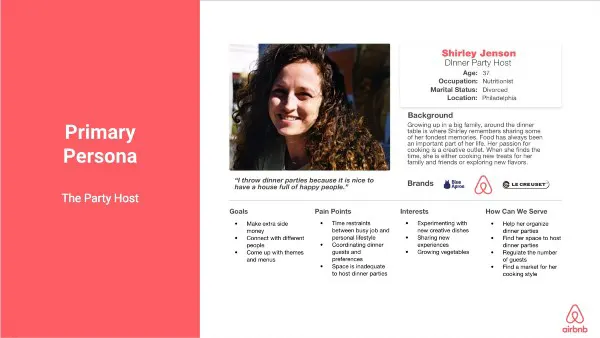
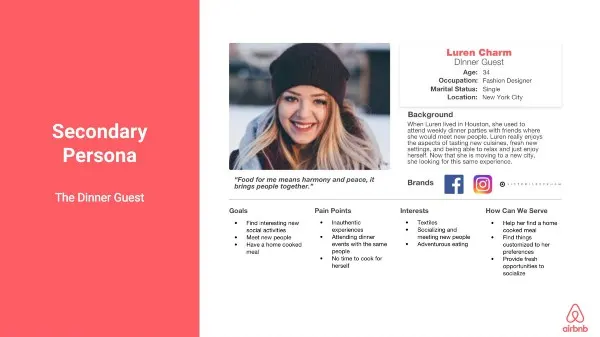
Source: Susana Charm’s UX portfolio
Each persona features a concise demographic profile detailing the user’s age, occupation, marital status, and location; a background summary to provide further context; an overview of the users’ goals, pain points, and interests; and a user quote.
To make the personas actionable, Susana has also included a section titled “How can we serve”. This explores the goals each persona would like to accomplish when using Airbnb for social eating.
The user personas were used to prototype an event creation and management platform that integrates with Airbnb venue booking.
You can read the full project case study on Susana Charm’s portfolio website.
ii. Money Manager app user personas created by Rishabh Gagneja
The project:
Money Manager is a mobile app used for personal budgeting and expense tracking. UX designer Rishabh Gagneja completed an unsolicited redesign of the app for his portfolio, following the design thinking process from start to finish.
As part of the ‘empathise’ phase, Rishabh conducted user research to inform the creation of user personas.
The process:
Rishabh started his research by getting to know Money Manager’s existing user base. He read reviews by real users on the Play Store to identify what people like and dislike about the app. He then conducted six user interviews to delve deeper into how people use the app to track their expenses.
The user personas:
Based on his findings from the research phase, Rishabh created two user personas:
- Rahul Singh, a college student
- Daya Singh, a housewife
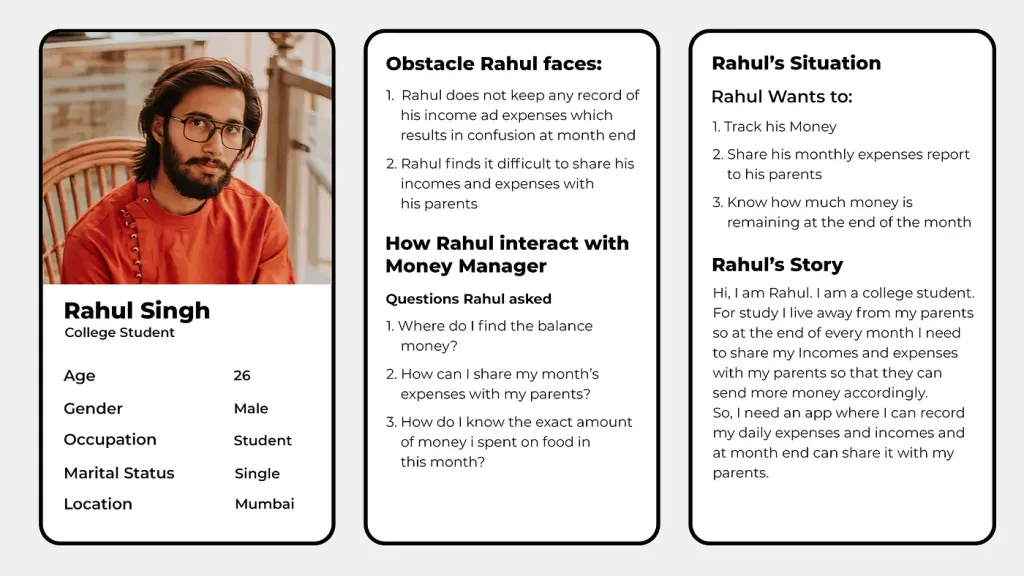
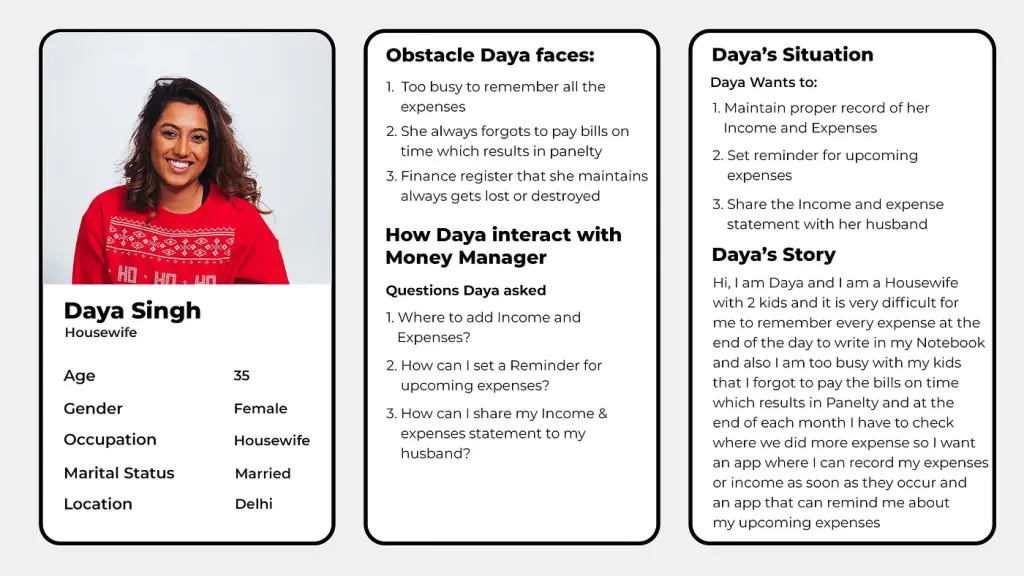
Source: Medium
Rishabh’s Money Manager user personas are heavily goal-based, exploring how each persona interacts with the app, the tasks they want to accomplish while using it, and the pain-points they face with the current design of the app.
Each persona also includes a story, providing a first-hand snapshot into what the user’s day-to-day life looks like and the role the Money Manager app plays in helping them achieve their goals. This fosters empathy and makes the personas memorable and relatable.
Based on these personas, Rishabh went on to define the problems he wanted to solve with the app redesign, conduct competitor analysis, and ideate potential solutions.
You can read all about Rishabh’s Money Manager app redesign here.
iii. Bumble BFF user personas created by MacKenzie Legg
The project:
Bumble BFF is a mode within the Bumble dating app that helps people make new friends. As part of her UX design studies, designer MacKenzie Legg explored how the app could be adapted and improved to provide additional value during the Covid-19 pandemic.
The process:
MacKenzie wanted to explore how people were using Bumble BFF to deal with social isolation during Covid-19 restrictions that required them to stay at home. She began her research with user interviews. This enabled her to identify key pain points that Bumble BFF users were experiencing during the pandemic, and to divide users into two distinct groups:
- The Power User: Bumble BFF users who have made multiple connections through the app and use it as their main source of networking.
- The Novice User: Those who have just moved to a new location and are trying the app to make new connections, but haven’t yet made any meaningful connections (meaningful connections are defined as those resulting in more than one meet-up with the same person).
The user personas:
To represent the two user segments, MacKenzie created the following personas:
- Isabella, an extroverted undergrad student in her early 20s (a Novice User)
- Brenda, an outgoing working professional in her early 30s (a Power User)
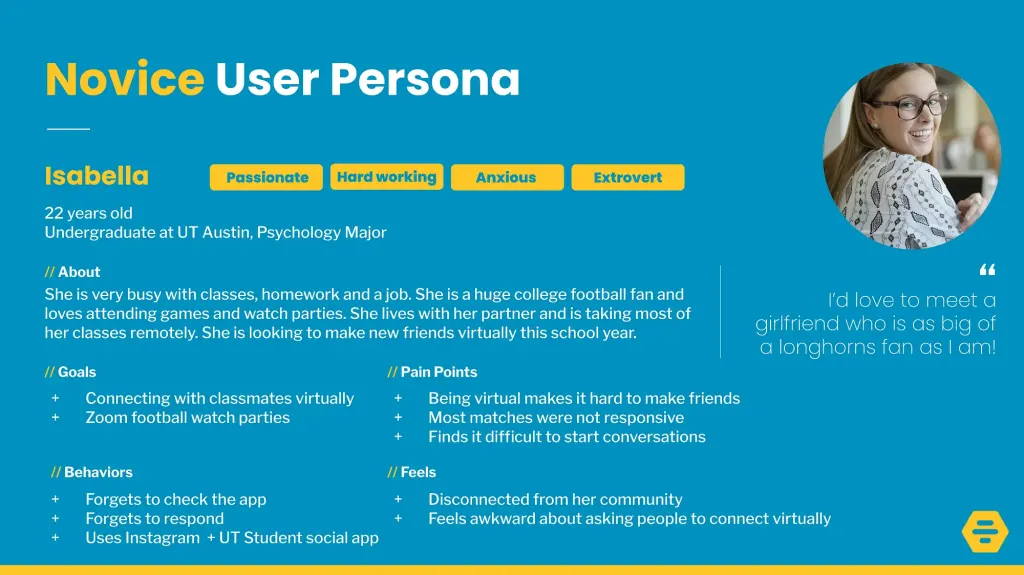
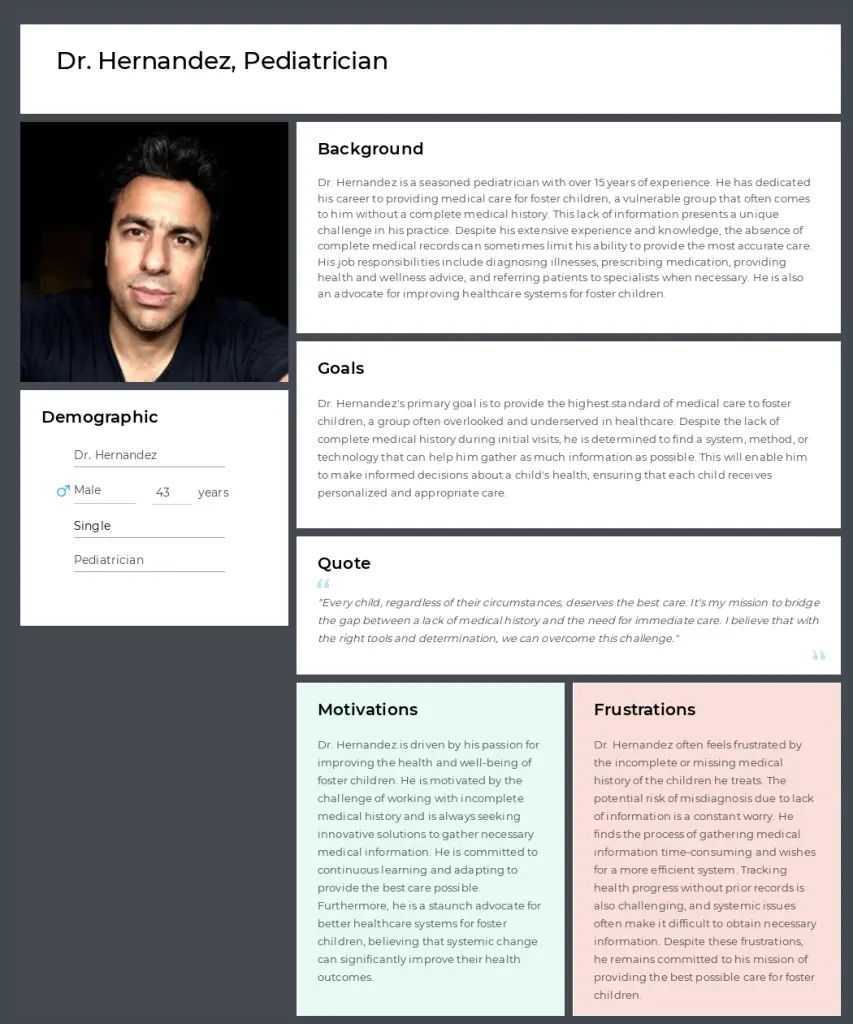
Source: MacKenzie Legg’s portfolio
MacKenzie’s Bumble BFF user personas are less focused on demographic details, providing only the persona’s age and occupation. Instead, they focus more on the target users’ personality traits, goals, behaviours, and pain-points.
The personas also include a section detailing how the user feels, with statements such as “Feels energised about meeting new people, cautious about online security” and “Feels disconnected from her community, feels awkward about asking people to connect virtually.”
This helps to bring the personas to life, tuning in to the emotions and challenges of the real Bumble BFF users they are designed to represent.
Learn more about MacKenzie’s Bumble BFF case study and how she used her personas to inform design decisions here.
iv. Healthcare app user personas created by Joseph Burford
The project:
As the UX designer on a redesign project, Joseph Burford was tasked with improving the accessibility and overall user experience of the Health Passport app—a portal used by members of a children’s foster care team to access and manage children’s medical history.
In its existing state, the app presented challenges related to access, efficiency, intuitiveness, and security.
The process:
During the discovery phase of the project, Joseph set out to understand the needs, goals, and pain-points of each key member of the foster care team. He conducted 25 in-depth user interviews involving various stakeholders: service coordinators, caregivers, case workers, providers, psychiatrists, and clinic managers.
Throughout the interviews, Joseph uncovered key insights into the main challenges faced by those using the app, such as critical information gaps, fragmented information retrieval, diverse information sources, and communication barriers.
The user personas:
To represent the main stakeholders whose needs should be factored into the redesign, Joseph created three role-based user personas:
- Dr. Hernandez, the paediatrician
- Lisa, the service coordinator
- Sarah, the caregiver

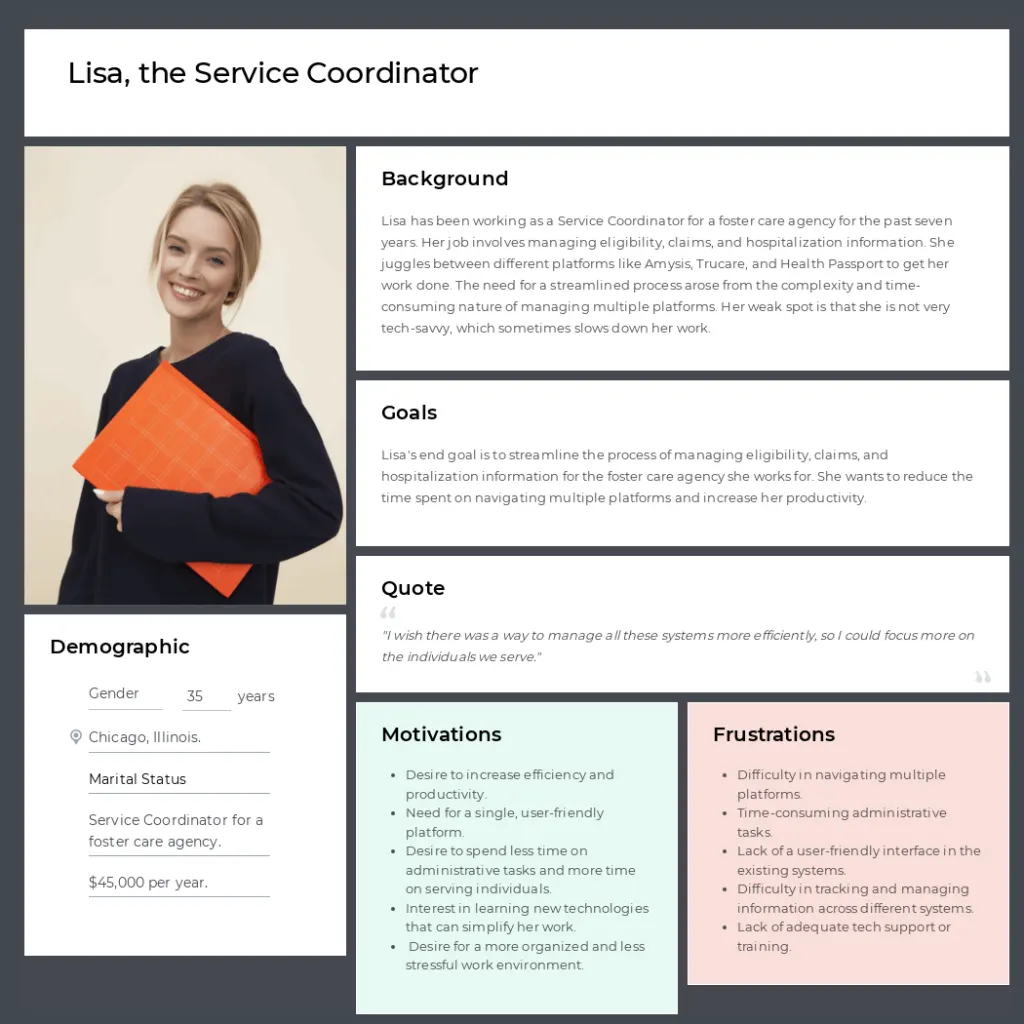
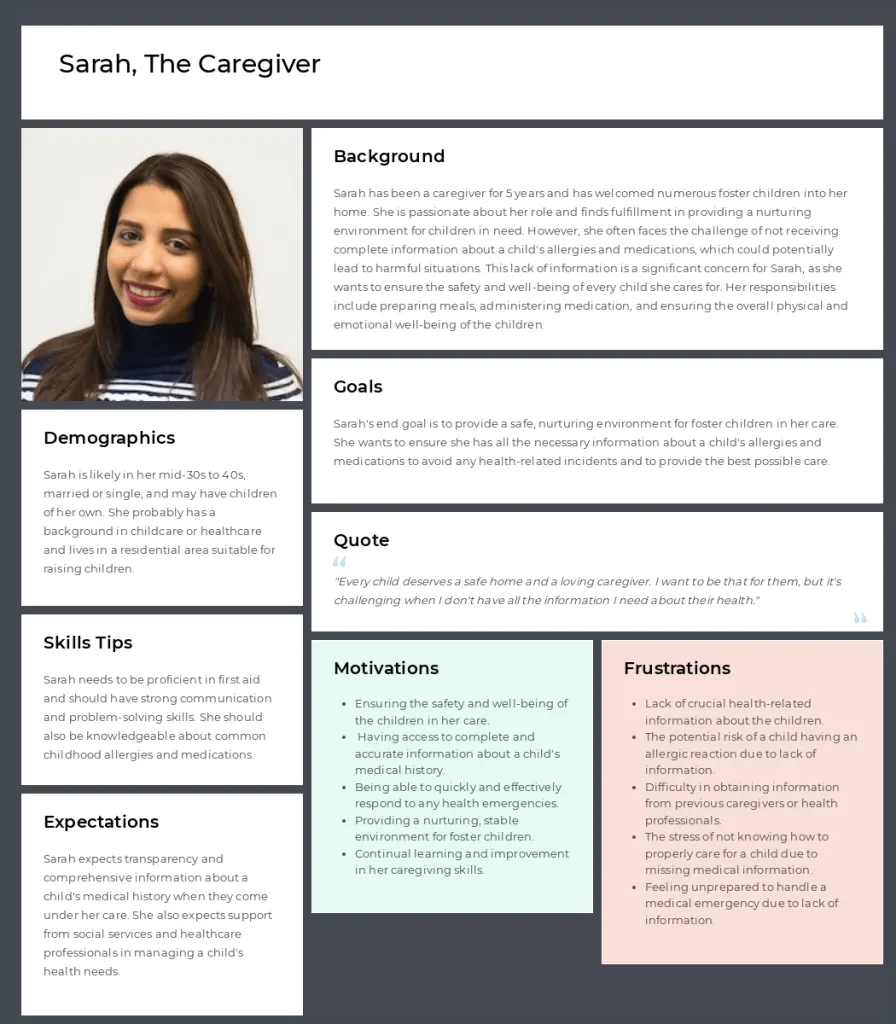
Source: Joseph Burford’s portfolio
Each persona gives a detailed description of the user’s professional background and the challenges they currently face within their role. It then goes on to explore their goals, motivations, and frustrations.
The persona for Sarah, the caregiver, dives even deeper into how the user interacts with the product, outlining the skills and proficiency this particular user should have, as well as the expectations they have within their professional role.
Joseph’s healthcare personas are a combination of goal-based and role-based, focusing primarily on what the users need to achieve in a specific organisation.
Read more about Joseph’s Health Passport redesign project here.
v. Mindful OS user personas created by Jake Burke
The project:
“Smartphones monopolise attention and consume users’ time much more than they would like.”
That’s the challenge that UX designer Jake Burke set out to address with his Mindful portfolio project. To help users manage how much time they spend using their smartphones, Jake designed an extension of Apple’s iOS 11 that offers handy time-management features without compromising functionality.
The process:
During the research phase, Jake conducted semi-structured interviews with smartphone users to identify key behaviours and challenges associated with excessive smartphone usage.
Jake found that, despite a tendency to constantly check their smartphones even if they haven’t received a notification, the people he interviewed expressed that they do not want or need to be on their smartphones all day, felt overwhelmed by notifications, and recognised that they used their smartphone excessively but did nothing about it.
The user personas:
After analysing the user interviews, Jake outlined the main attributes and characteristics that he felt best captured the target audience. Based on those attributes, he categorised his users as follows:
- Users who are conscious of their smartphone overuse and want to reduce usage
- Users who value time away from their phone without consequence
- Users who value productivity and focus
- Users who value getting their information efficiently
- Users who are overwhelmed by notifications
He then created three user personas to represent people who are negatively affected by smartphones:
- Anne Leung, a university student in her early 20s
- Andre Spencer, a working professional in his early 30s
- Sara Campbell, a stay-at-home mother of three in her 40s
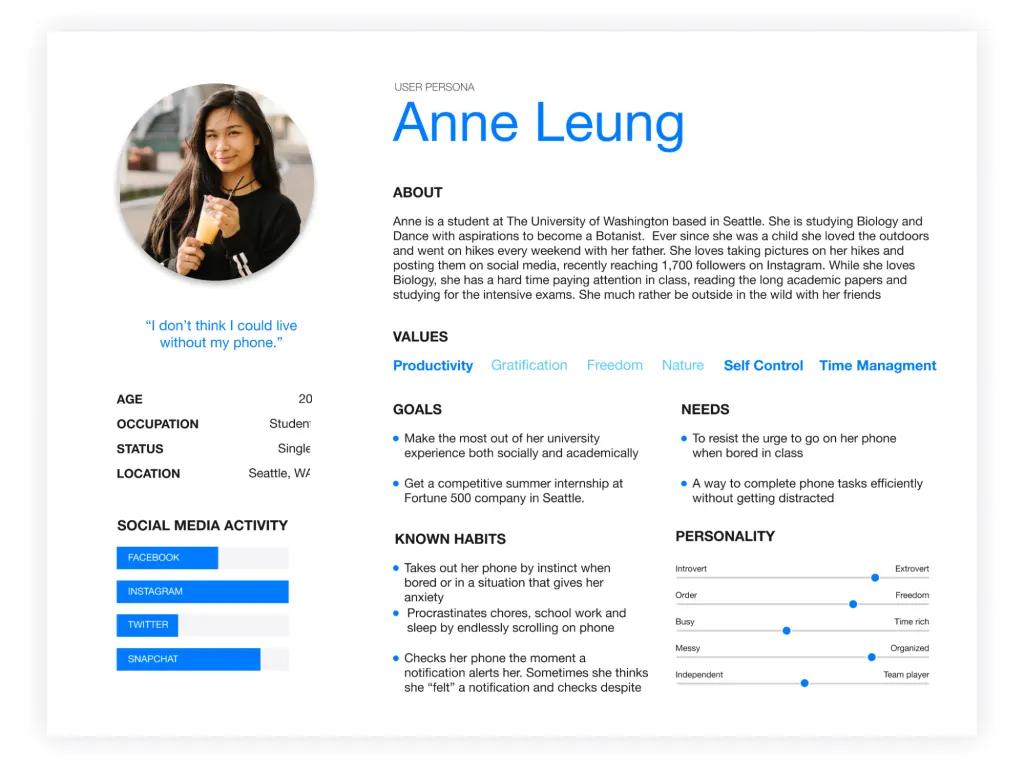
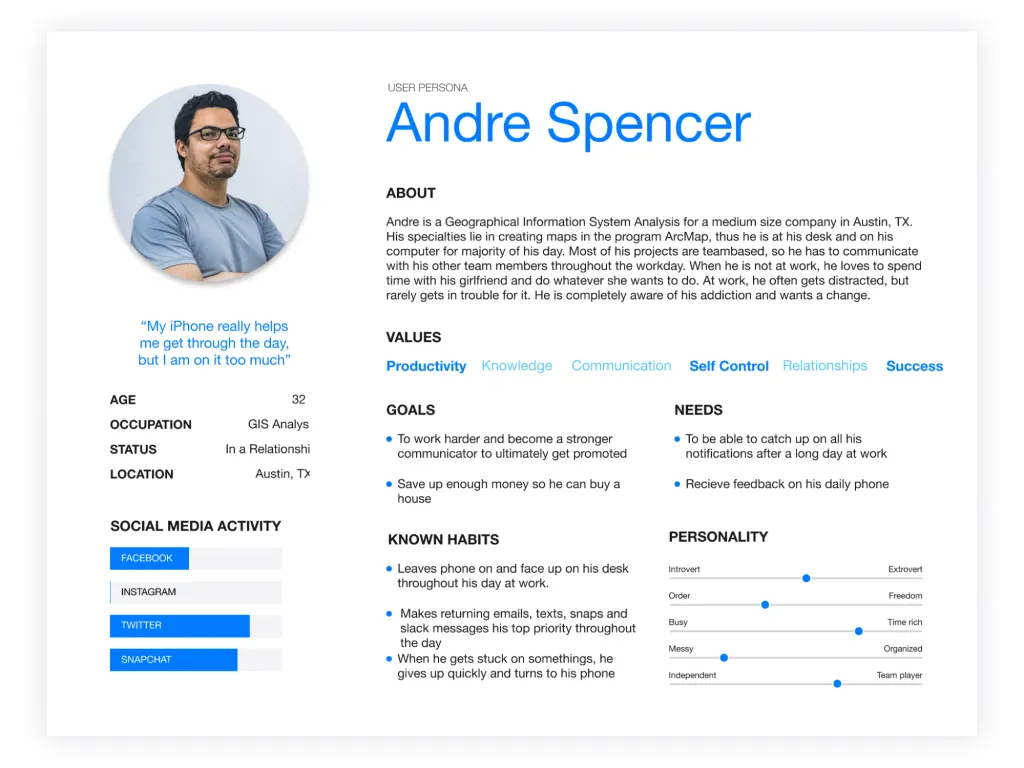
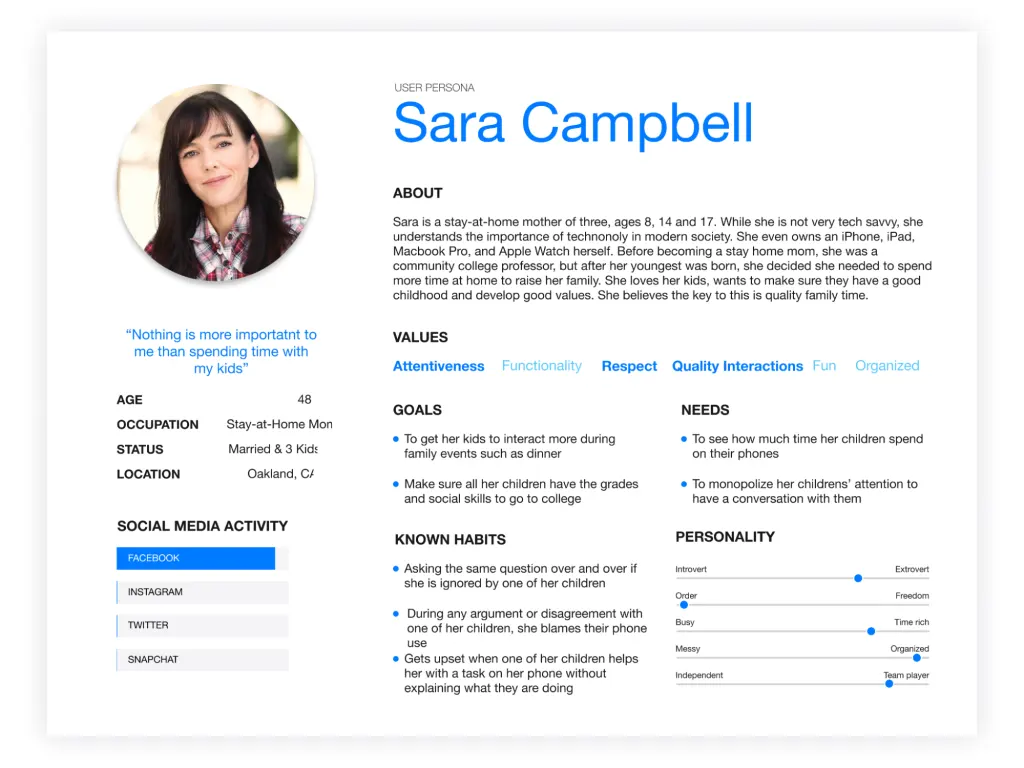
Source: Jake Burke’s portfolio
Jake’s personas are incredibly detailed, providing rich insight into each user’s daily life and tech habits, their values, needs, and goals, and their most relevant personality traits. The personas also give a clear visual breakdown of each user’s social media activity, with progress bars to show which platforms take up most of their time.
With his three core personas in mind, Jake went on to identify concrete pain points within the smartphone interface—such as a cluttered lock screen, too many irrelevant notifications, and a lack of visibility into smartphone usage.
He then created scenarios and storyboards to illustrate how his user personas might experience the various pain points in their daily lives. This enabled him to come up with design requirements and eventually ideate potential solutions.
Read the entire Mindful case study on Jake’s portfolio website.
How to get started with your own user personas
Based on our examples, you now have ample insight into what user personas look like and how they help designers create valuable, user-friendly solutions.
Ready to create your own user personas? Here’s how to get started.
i. Define project goals and conduct research
First, define clear goals for your project. Articulate the problem or challenge you want to solve and why. This will guide your user research efforts and, eventually, your personas.
With a clear idea of what you want to achieve, the next step is to conduct user research. This enables you to get a sense of who your target users are, to learn about their needs, goals, and challenges, and to better understand how they behave in relation to the problem you’re solving and the product you’re designing (or redesigning).
User research typically comprises user interviews, surveys, diary studies, and focus groups. The methods you choose will depend on the time and resources you have available, but each should provide valuable insight into your audience.
ii. Analyze your research data
Next, analyze your research data to identify patterns and themes, pull out the main problems your users face, and assess differences and similarities within your user base.
For example, you might find that all of your research participants express a common desire to make healthier food choices at lunchtime, but that they have varying motivations for doing so—and that they face different challenges when it comes to achieving this goal.
Based on your analysis, segment your audience into different user types. These will inform your personas.
iii. Create a user persona for each segment
You’ll now create a unique persona to represent each segment of your user base.
Decide what type of persona to create—traditional, role-based, or goal-based (or a combination of role- and goal-based, similar to Joseph Burford’s healthcare app personas).
Then determine the format and layout your user personas should follow. To help you with this step, we’ve compiled a selection of free user persona templates; you can either choose an existing template to customize, or use them as inspiration to create your own.
Fill out each persona with a name, a demographic profile, a descriptive summary, needs, goals, and pain points—and any other information you deem relevant for capturing your end users’ perspectives.
Those are the fundamental steps you’ll need to follow to create effective user personas. For more detailed step-by-step instructions, refer to the how-to section of our complete guide to user personas.
Key takeaways and additional resources
User personas provide an easily digestible summary of your target users’ needs, goals, and pain points. They turn your research data into something human, memorable, and relatable—which is essential for cultivating empathy and making sure you design with real people in mind.
For more tools and resources to help you create meaningful, user-friendly products and experiences, check out these guides:
- 17 Fundamental UX Design Principles and How To Apply Them
- Everything You Need To Know About Creating Wireframes
- The Best UX Design Tools and Software To Use in 2024
Want a professional UX qualification? Consider a UX design course. At AND Academy, you’ll learn all the core principles, tools, and processes you need to excel as a UX designer. From conducting user research to creating user personas, wireframing, prototyping, and usability testing—you’ll cover it all with live, expert-led sessions, practical project work, and personalized mentorship.
Here are some other resources that you could use at this stage:
- Watch this session by Shiva Viswanathan, Design Head of Ogilvy Pennywise, and Naman Singh, Product Experience Designer at RED.
- Talk to a course advisor to discuss how you can transform your career with one of our courses.
- Pursue our UI UX Design coursewhich is taught through live, interactive classes by industry experts, and comes with a Job Guarantee.
- Take advantage of our scholarship and funding options to overcome any financial hurdle on the path of your career transformation.
Note: All information and/or data from external sources is believed to be accurate as of the date of publication.









